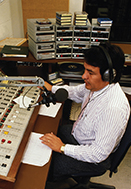Radio
In a radio studio such as the one in Figure 10, music and voices that have been changed into electronic signals are coded onto radio waves and then broadcast. There are two ways that radio stations code and transmit information on radio waves. Both ways are based on a wave of constant frequency and amplitude. To code the information onto this wave so that it can be broadcast, one of two characteristics of the wave must be varied, or modulated.
Radio Broadcasting
Figure 10 The announcer's voice and the music on CD leave the radio studio as electronic signals. Those signals are used to produce a wave with either a varying amplitude or a varying frequency. A AM waves have a varying amplitude. B FM waves have a varying frequency.

In amplitude modulation, the amplitude of the wave is varied. The frequency remains the same. AM radio stations broadcast by amplitude modulation. In frequency modulation, the frequency of the wave is varied. The amplitude remains the same. FM stations broadcast by frequency modulation. Whichever way the radio wave is transmitted, your radio receives it, decodes it, and changes it back into sound waves you can hear.
Have you ever traveled a long distance in a car and “lost” a station on the radio? A station is lost when its signal becomes too weak to detect. An FM radio station is more likely to be lost than an AM station because FM radio signals do not travel as far as AM signals along Earth's curved surface. AM radio stations use frequencies between 535 kilohertz and 1605 kilohertz. FM stations use frequencies between 88 megahertz and 108 megahertz. Particles in Earth's upper atmosphere reflect the lower-frequency AM radio waves much better than the higher-frequency FM radio waves. The reflection helps transmit AM signals farther.
Television
Radio waves also carry signals for television programming. The process is like transmitting radio signals. But one difference is that the radio waves carry information for pictures as well as for sound. Once they have been broadcast, the signals are received by an antenna, and sent to the TV set.
Location and weather can affect the reception of television signals by an antenna. For that reason, many people prefer to receive television signals that have been transmitted by satellite. With this type of transmission, TV broadcasts are sent to satellites, which then retransmit the signals back to Earth.
If you have a satellite dish, you can receive the signals directly. If not, a cable service can receive the signals and resend them to your home.




